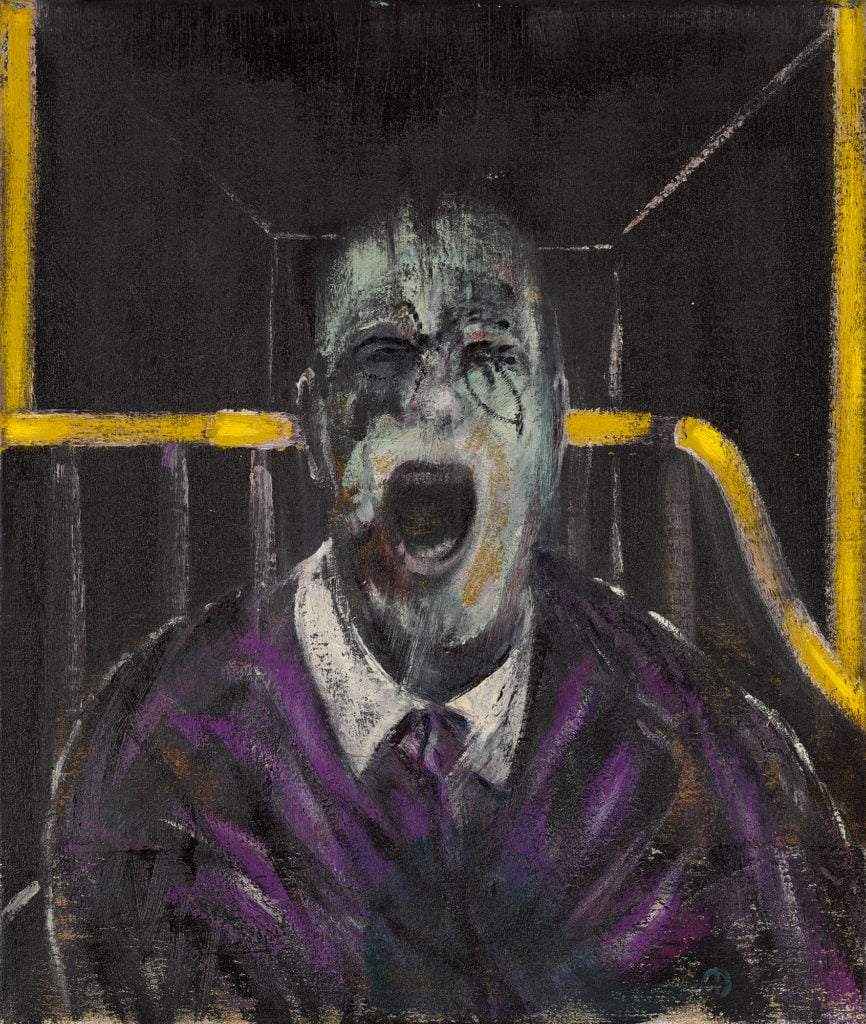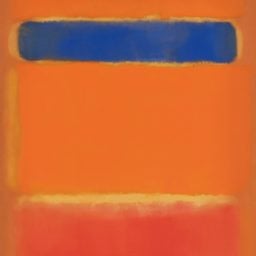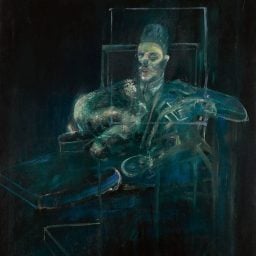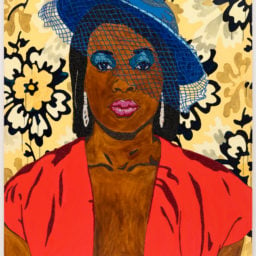Nearly two and a half hours of lively bidding, particularly for premier lots by Francis Bacon and Mark Rothko, assured Sotheby’s contemporary evening sale a vigorous showing to nearly close out New York’s May auction week on Thursday night. The sale’s premium-inclusive total of just under $342 million clawed tantalizingly close to its pre-sale high estimate of $351.4 million, with two Bacons and one Rothko together accounting for $115 million of that total. (Final prices, unless otherwise noted, include buyer’s premiums. Pre-sale estimates do not.)
All told, 56 of the 63 lots consigned to the sale found buyers, producing a robust 89 percent sell-through rate. Refreshingly, zero lots were withdrawn at the 11th hour, indicating the house entered the sale feeling confident in buyers’ interest from top to bottom.
The mood in the salesroom matched expectations, as 50 lots, or 79 percent of those offered, boasted hammer prices within or above their pre-sale estimates. (Twenty-eight within, 22 above.) The auction also included records for seven artists, ranging from canonical figures like Carl Andre, Lee Krasner, and Kenneth Noland to recent stars Charles Gaines, Barkley L. Hendricks, Rashid Johnson, and Dana Schutz.
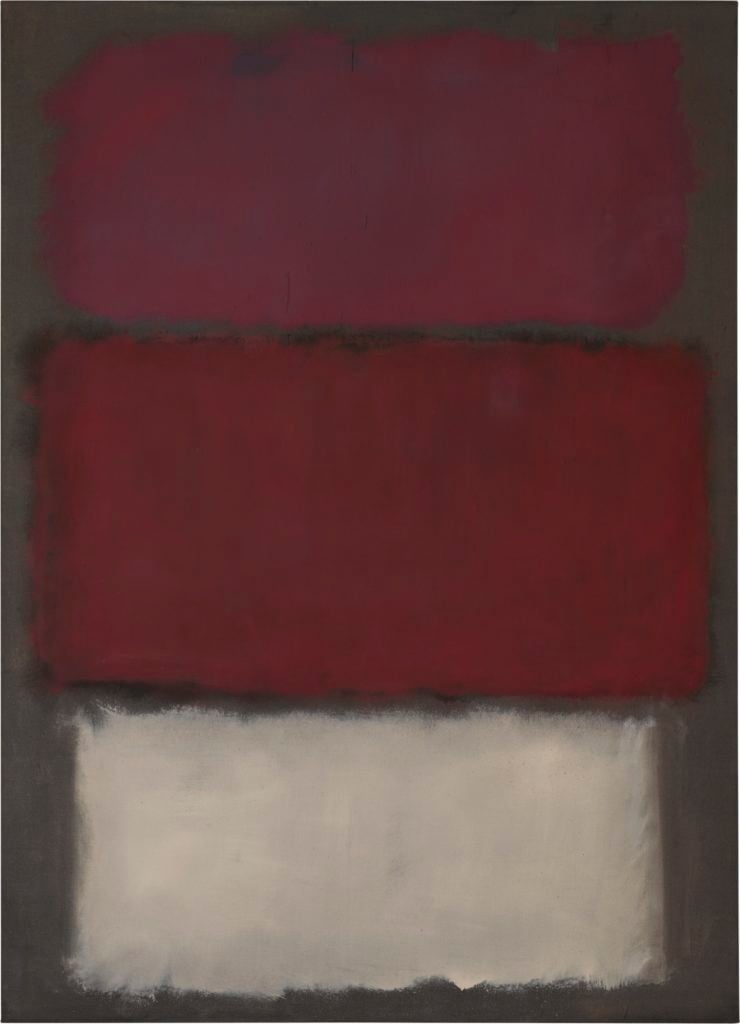
Mark Rothko, Untitled (1960). Courtesy of Sotheby’s.
COMPARE AND CONTRAST
As a whole, Sotheby’s contemporary evening sale climbed nowhere near as high as the knee-buckling $538.9 million brought in by its midtown rival the night prior. But based on pre-sale valuations, only a lousy gambler would have placed a bet on the opposite, and the works expected to perform especially well at Sotheby’s largely did so.
Francis Bacon’s Study for a Head (1952) proved to be the evening’s highest-seller. Consigned to Sotheby’s after spending nearly four decades in the Seattle-based collection of Richard E. Lang and Jane Lang Davis, the close-cropped visage of one of Bacon’s tortured popes had been one of the first works by the artist to be acquired by a private US collector. The work smashed through its pre-sale high estimate of $30 million, hammering at $44 million and ascending to $50.4 million with premium after roughly five minutes of action.
One sale with far-reaching consequences for the public was Mark Rothko’s Untitled (1960), which hammered for just under $43.8 million against a pre-sale estimate of $35 million to $50 million. The buyer’s premium lifted its on-paper total to $50.1 million, coming within shouting distance of Bacon’s screaming pontiff and notching the night’s second-biggest sale. The San Francisco Museum of Modern Art deaccessioned the somewhat subdued canvas, which arrived in its collection through a gift of Peggy Guggenheim, with the explicit intent “to broadly diversify its collection, enhance its contemporary holdings, and address art-historical gaps” with the sales proceeds—a growing trend in North American museums.
In the February announcement, SFMOMA hinted that it would be able to reveal the first of the works acquired by the end of May, but the size of its war chest may not reflect the entirety of tonight’s sales price. Untitled carried both an in-house guarantee and a third-party irrevocable bid. Either way, the institution undoubtedly has ample resources to revise its collection.
Another pre-sale focal point was Lee Krasner’s The Eye Is the First Circle (1960), estimated to sell for $10 million to $15 million. Apart from tonight’s consignor, the stormy, earth-toned abstraction had only one previous owner, the Pollock-Krasner Foundation—making the work fresh-to-market at a time when pieces by traditionally overlooked women are magnetizing widespread attention.
The work matched, but did not exceed, expectations by hammering to dealer Robert Mnuchin for $10 million—equal to the low estimate, and more than enough to set a new auction high for the artist at over $11.6 million including fees. However, a combined guarantee and irrevocable made that result irrelevant to the seller’s finances.
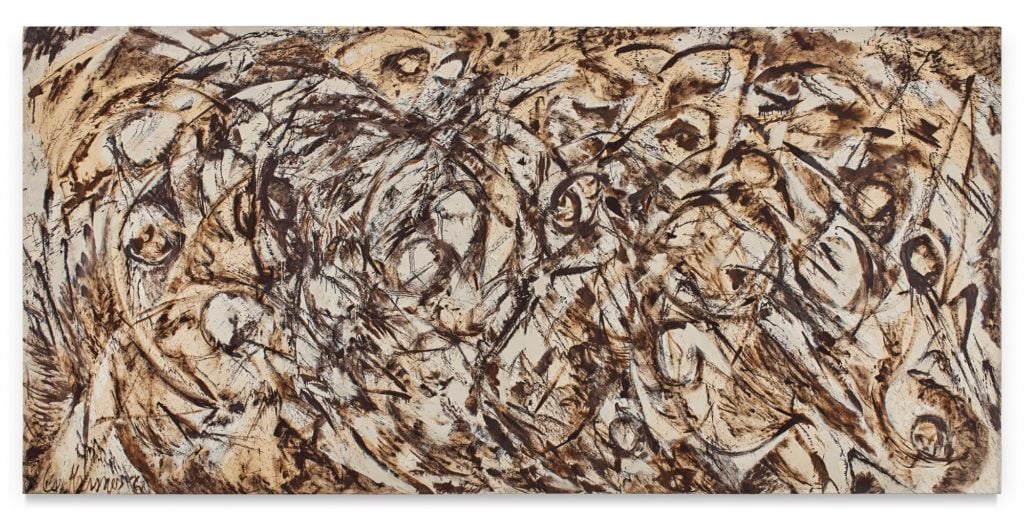
Lee Krasner, The Eye Is the First Circle (1960). Courtesy of Sotheby’s.
All of the above means that no single contemporary lot at Sotheby’s vaulted over the $91 million pledged for Jeff Koons’s metallic Rabbit at Christie’s contemporary evening sale on Wednesday night, a result that redelivered Koons the title of most expensive living artist at auction after that distinction had a six-month dalliance with David Hockney. Still, it’s worth noting that Sotheby’s did win bragging rights for the highest price paid for a single artwork across all collecting categories in New York this sales cycle, thanks to Claude Monet’s Meules bringing nearly $111 million in its Impressionist and Modern evening sale on Tuesday.
Financial instruments were more prevalent in Sotheby’s contemporary sale than its Impressionist and Modern campaign. Counting two last-minute additions announced at the sale’s outset, 19 of tonight’s lots were backed by an in-house guarantee, a third-party irrevocable bid, or both. (The Impressionist and Modern sale included just nine in its catalogue.)
Sotheby’s full haul also fell short of its equivalent contemporary evening sale last May, which generated nearly $391 million in total. However, that auction essentially parked another mini-sale—26 works from the Morton and Barbara Mandel collection—inside the larger main auction, like a mega-yacht toting a slightly smaller pleasure boat strictly for ostentation’s sake. The 76 lots consigned to the May 2018 sale comprised nearly 20 percent more than were consigned to the May 2019 sale, making the year-over-year comparison at least mildly questionable.
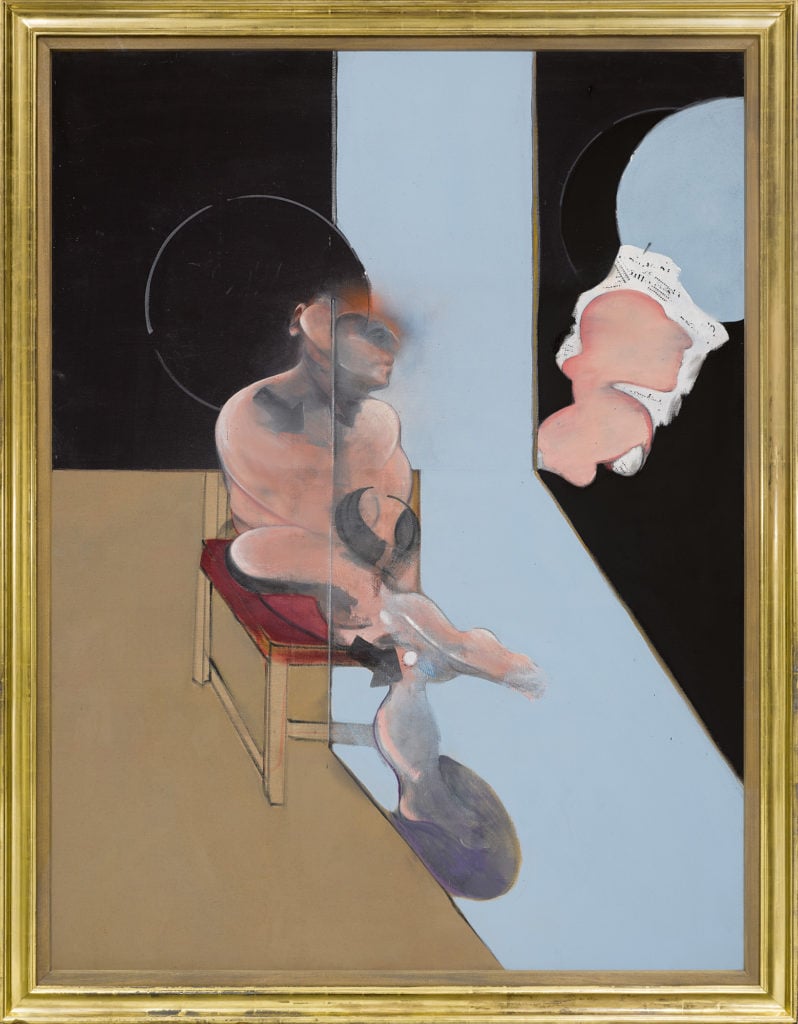
Francis Bacon, Study for Portrait, 1981. Courtesy of Sotheby’s.
COLLECTIONS ROUNDUP
In contrast to the pyrotechnics produced by works from the late S.I. Newhouse at Christie’s this week, Sotheby’s contemporary sale largely flew free of major estates. The evening’s most memorialized name was David Teiger, whose collection the house began selling in strategically distributed chunks last October. Another five Teiger works mounted the block tonight atop an estimate range of $10.3 million to $16.4 million, as well as the added security of five guarantees and two irrevocable bids. The group brought a collective hammer price of $12.9 million, which rose to $15.6 million with premium.
No Teiger work—and no work on the night, period—caused a wilder ruckus in the salesroom than Dana Schutz’s Civil Planning. Moments after Barker announced the lot, a guttural roar of bidding rose up from all sides, forcing him to play referee as much as auctioneer. The work hammered at $2 million, quintuple its high estimate, and reached $2.42 million with premium, or about three times her previous auction record.
Two other distinguished collections, however, supplied far more sales revenue than Teiger’s. Six works from the Gerald L. Lennard Foundation Collection brought a combined $45.1 million, while seven works from the Blema and H. Arnold Sternberg Collection added another $35.4 million. As with the Teiger quintet, every work offered from these notable sources found a buyer.
The highlight of the Lennard Foundation Collection was the second Bacon work of the evening: Study for Portrait, a 1981 oil that stands as the artist’s final rendering of his paramour and inspiration George Dyer. It hammered within estimate at $12.5 million and rose to $14.5 million with premium after a flash of bidding that lasted less than a minute. The buyer no doubt appreciated its attractively compact provenance, featuring only Marlborough Gallery and the foundation, which acquired the work some 36 years ago.
Most of the Sternberg Collection’s total came courtesy of two Rothko works on paper. Both executed in 1969 and hailing from the artist’s estate, Untitled (Red and Burgundy Over Blue) and Untitled (Red on Red) each saw auctioneer Oliver Barker bring down the hammer shortly after they met their low estimates of $9 million and $7 million, respectively. With premiums, their final prices reached $10.5 million and $8.2 million.
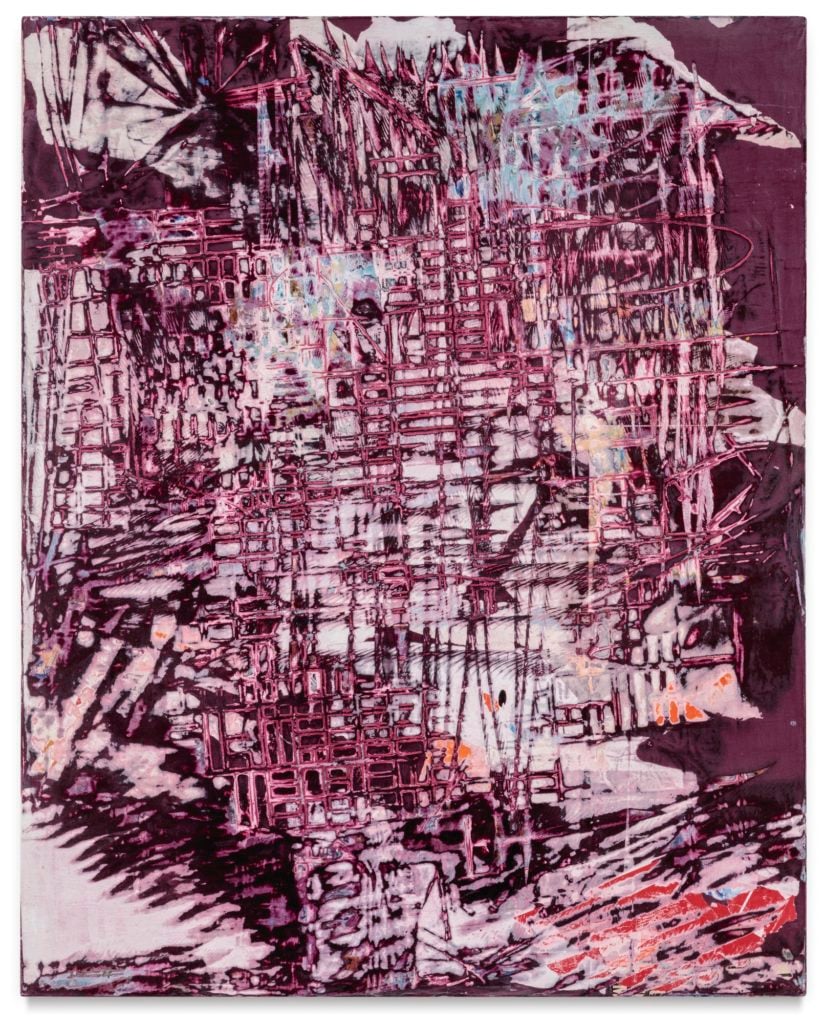
Mark Bradford, Scratch Pink, 2018. Courtesy of Sotheby’s.
A MUSEUM AND A CONTINUED TREND
Finally, tucked near the auction’s finale were a quartet of works donated by artists to benefit Los Angeles’s Hammer Museum. Featuring pieces by Mark Bradford, Charles Gaines, Mark Grotjahn, and Rashid Johnson, the micro-auction exceeded its collective high estimate of $4.3 million, hammering at $4.93 million and landing just shy of $6 million with premiums. Funds raised by the sale will go toward the institution’s exhibitions and public programs, at least slightly offsetting the donor-base impact of its $180 million Michael Maltzan-led architectural expansion.
The Hammer suite provided two of the seven artists records set during the auction. Charles Gaines’s Numbers and Trees: Central Park Series IV: Tree #6 hammered at $380,000—nearly twice its $200,000 high estimate—and swelled to $475,000 with premiums. (That premium-inclusive total tallied more than 8.5 times his previous auction record of $55,000.) Rashid Johnson’s work also found a new auction apex, when his Untitled Escape Collage hammered at $950,000 and climbed to nearly $1.2 million with premium, roughly triple his prior record.
The new highs for Gaines and Johnson nod to the feverish demand continuing to coalesce at auction around work by African American artists and artists of African descent. Sotheby’s sale featured 10 such artists, each of whom attracted hammer prices within or above their pre-sale estimate ranges.
In particular, buyers clamored for pieces by Robert Colescott, whose Garden Spot more than doubled its high estimate at $704,000; Barkley L. Hendricks, whose Yocks more than tripled its high estimate at $3.74 million, setting a new artist record; and Lynette Yiadom-Boakye, whose No Words of Gratitude nearly doubled its high estimate at $680,000. Whether these results are most about connoisseurship, speculation, or an overdue reappraisal of the historically under-appreciated, the market appears more than willing to give us continued reason to discuss.
